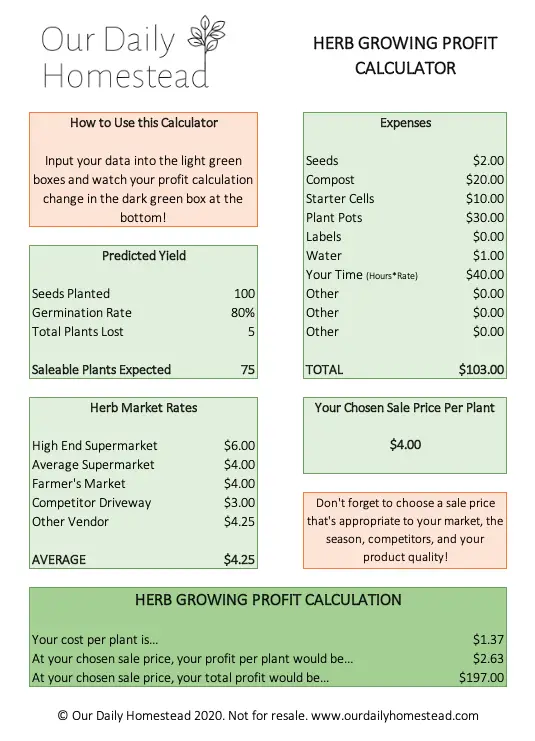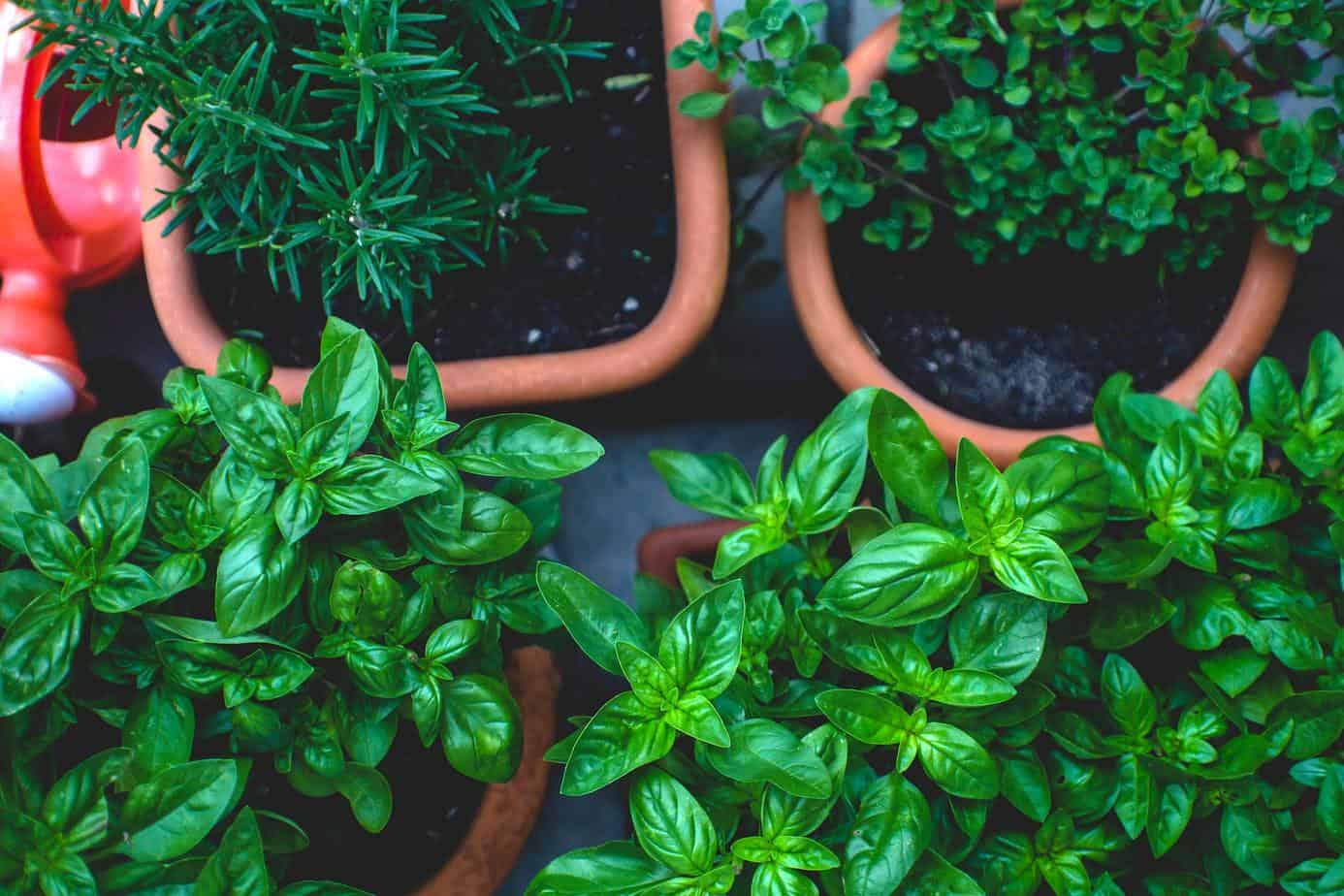Herbs are a wonderful thing to grow on a homestead. They are relatively easy to look after, they don’t have to take up much space, and it’s an easy way to save on the more expensive store-bought varieties. But having herbs on your homestead is not only a good way to save money. You can make money with them, too! Whether you offer them for cooking or medicine, herbs can make a great addition to your market stall or CSA box service. If you are hoping to make money from your herb garden, though, you will need to know how to calculate the most profitable herbs to grow. Keep reading to find out how to do so!
Understanding Herb Expenses
Whenever you are trying to figure out how much money something can make you, it’s best to start off by looking in detail at your expenses. With herb growing, you aren’t likely to accrue a huge amount of expenses, but expenses can crop up (excuse the pun!) where you least expect them. You also have to take into account the risk of loss and how that could impact your herb growing profits.
What are the basic herb growing expenses?
When making predictions for the most profitable herbs to grow, you have to think beyond the expense of the seeds. In general, you should consider the costs of:
- buying seeds or a seed-bearing plant
- ensuring nutrient-rich soil
- acquiring things to grow the seeds in (seed-starting trays, pots, planters, etc.)
- watering your herbs
- tools and other equipment (snips, herb scissors, hand trowels, etc.)
Your exact expenses will vary depending on your existing equipment and, indeed, the costs of buying new items. But, in general, the above five areas will be where you incur costs in herb growing.
Example: Selling basil in your driveway farm stand
For example, let’s assume you want to grow some basil (easily one of the most profitable herbs to grow!) to sell as plants at the end of your driveway. You’re only doing a little test run, so let’s assume you only want to buy one packet of seeds and see what happens. Firstly, here’s what you’ll need and what you might expect everything to cost:
| Item | Cost | Quantity per Packet | Packets Needed | Total Cost |
|---|---|---|---|---|
| Basil seeds | $2 | 100 | 1 | $2 |
| General-purpose organic compost | $20 | 20 cf | 1 | $20 |
| Paper start cells | $5 | 50 | 2 | $10 |
| Eco-friendly plant pots | $15 | 50 | 2 | $30 |
| Water | $1 | – | – | $1 |
Now, of course, there’s going to be a lot of variation in these costs. But the principles stand. Accordingly, list out everything you need and what it might cost you. You could have some compost laying around, making that free. Or you could be collecting rainwater from your property, so that makes your water free. Your neighbor might have some old pots you can use, making those free. Or just be inventive to bring your costs down (ever made your own paper pots?) Either way, the point is, create a list of your expenses and input your own costs to get accurate figures for your situation.
Don’t forget germination rates!
Assuming those were the costs, though, we’re looking at $63 total. Basil seeds have a germination rate of about 80-90%, so let’s assume we get 80 successful germinations out of those 100 seeds. Now let’s assume a few more plants, unfortunately, don’t make it for one reason or another (transplant shock or whatever – although that should be reduced if you’re using biodegradable paper cells). And now we’re shootin’ for 75 plants to be able to sell in the end.
If we manage to get 75 plants out of our little growing project, the cost per plant to us is $63 divided by 75, which is $0.84 a plant. Bargain!
How do I account for the value of my time in herb growing?
Equally important in this math is your time. But in the table above, you may have noticed that I didn’t take into account the time it will actually take you to grow all these basil plants. There is, therefore, an important cost missing from that analysis.
If you are really interested in finding the most profitable herbs to grow, you have to think about (a) how much time it will take you to grow the herbs and (b) how much your time is worth. Accordingly, for (a), take into account the time you actually spend tending to the plants and preparing them for sale. Similarly, for (b) – a much harder question – try to assign yourself an ‘hourly rate’. Unquestionably, your time is not free. Indeed, it is a limited quantity resource and if we’re thinking purely financially, it could be spent earning money in a part-time job elsewhere. As a result, we have to bring our time into the equation somehow.
As for the value you pick, it doesn’t really matter too much as long as you think it’s a reasonable figure to place on your time, taking into account the activity at hand. Accordingly, here are some options…
How to ‘value’ your time
- federal minimum wage ($7.25 an hour in the US in 2019)
- average wage of someone working at a plant nursery (about $10 an hour)
- amount it would cost you to pay someone else to do it (likely a max. of $15 an hour)
Again, the exact number doesn’t matter too much as long as you’re not going crazy high or crazy low. The goal here, therefore, is to reflect the value in your time and ensure we have a more accurate profit calculation.
So, going back to our expenses, let’s assume it takes me four hours in total to grow and prepare my plants for sale. My hourly rate is $10, so that adds $40 to my costs. My 75 plants now cost me $103, making my overall cost per plant $103 divided by 75, which is $1.37. Still not bad compared to store-bought basil plants!
Does the risk of loss impact profits?
In our expenses calculation, I made sure to account for loss when I was totaling up our costs per plant. This is a really important step, but many people forget to do it. Generally, it’s better to be conservative here. Therefore, assume the lowest reasonable germination rate and that you’re going to lose a handful of plants along the way. If you are a complete beginner, assume you’ll lose a few more, and likewise, if you’re an experienced gardener, assume you’ll lose fewer. There is no way of predicting these things, so the best thing to do is just assume that some loss will occur somewhere, and then if it doesn’t, your profit margins go up in the end!
Understanding Herb Market Prices
Once you’ve totaled up your expenses and worked out a per plant cost to you, you need to figure out what you could potentially sell these for at your market stall, as part of your CSA box service, or at the end of your driveway. Of course, there is, again, no exact science to this. Accordingly, the cost will vary a lot depending on your geographic area, whether you ensured everything was certified organic, and a host of other supply and demand factors (season, availability, market size, etc.). What is important here is to do your research and try to figure out a fair market price. Indeed, go too high and someone might just pass the opportunity, and go too low and you risk leaving money on the table (which could be used to buy more seeds!).
How to price your herbs
Generally, the way I approach this is to find three or four different prices of basil plants available in my area, and just come up with a rough average. It’s important to realize the math doesn’t need to be perfect here. In brief, and for the sake of our example, let’s say prices in my area are as follows:
- High-end supermarket – $6
- Average supermarket – $4
- Farmer’s market – $4
- Competitor driveway – $3
Some places will, of course, be more expensive than others, but in this instance, the mathematical average price is $4.25. Not too shabby! Then, we have to decide where we want to fit in the market. If we see our organic basil as a premium product, we might advertise it at $4 at the end of the driveway. Yes, we’re a whole dollar more than our competitor, but maybe our stand looks nicer and we’ve laid our products out better and we’re organic whereas they aren’t. Correspondingly, ours is worth the extra dollar.
Or, maybe we are pretty similar to the competitor and we want to up our game by offering other products on the stand, not just basil. In that case, we could probably charge $3 per plant and be OK with that, as we might make other sales. As can be seen, it’s best to take a few different factors into account.
Calculating herb growing profits
For example, let’s say I settled on the $4 price tag. I get my plants out at the end of the driveway in batches of ten plants at a time (if there are fewer plants out there, people may sense scarcity so they’re more likely to buy a couple in case you’re running out).
Then, let’s assume we do actually sell all 75 plants – our project has been a resounding success! We’ve taken $4 for each of the 75 plants, meaning our revenue (income) from this project is $4 multiplied by 75, which is a lovely $300.
But, remember, our revenue is not our profit. At this point, to find our profit, we have to subtract the expenses we listed above from our total income.
The (very) basic calculation
$300 (Revenue) – $103 (Expenses) = $197 (Profit)
As can be seen, in our little pretend basil growing project, we made $197. Not bad considering we have already been paid for our time (remember, we included an hourly rate for our time in the expenses). To reduce this back to an hourly rate, we should recall that it took us four hours total to grow and prepare our basil plants for sale. If we take our $197 profit, divide it by four, and then add that figure to our existing hourly rate of $10, we come out with an overall hourly rate of $59.25. Very nice indeed.
Generally, this figure is about right for home growing. A study in the Journal of Extension found that for every $1 spent on materials and supplies, a gardener could expect to grow around $2.84 worth of fruits and vegetables. Herbs, it would seem, could be a little more profitable than the average fruit or vegetable. In our example, we got $2.91 for every $1 spent. But again, everything depends on how quickly the expenses pile up and what rates you can sell your crop for.
Want More Help Figuring Out the Most Profitable Herbs to Grow?

If this article on how to calculate the most profitable herbs to grow has been useful for you, you may be interested in a spreadsheet I made for these exact calculations!
As I have shown on the right, the spreadsheet not only lists all the potential costs you could incur in herb growing, but it also provides you with a calculator to help you figure out the pricing of your herbs so you can (hopefully!) make a profit.
Want to get your hands on it?
Simply sign up for my monthly email newsletter below and I’ll send it to you for free in your welcome email!


